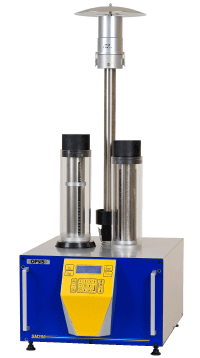
The PM
2.5 monitor version of OPSIS’ SM200 particulate monitor offers accurate and reliable automatic measurements of PM
2.5 particulate fraction concentrations in ambient air, and sampling of the PM
2.5 particulate fraction for later manual analysis.
The SM200 instrument utilizes a standardized inlet head which can be operated at a flow rate of either 1.0 or 2.3 normalized cubic metres per hour. The sampled air is forced through a 47 mm filter; typically made of Teflon but it can also be made of cellulose or glass fibre. During the sampling process, the particles are accumulated on the filter. After sampling, the amount of particles collected on the filter is measured using the
beta attenuation method. This and knowledge about the air flow which is accurately monitored and controlled then yields the average particulate concentration during the sampling period. Used filters are preserved and can retroactively also be analysed for specific particulate pollutants such as air-borne cadmium, nickel and other metals.
The instrument provides several communication options for simple system integration, and can be remotely supervised. The instrument can be used stand-alone on its own merits, but is often combined with
OPSIS gas analysers and other sensors to form a complete
ambient air quality monitoring station.
The SM200 instrument has multiple, automatic quality assurance and quality control procedures, securing reliable monitoring results with high accuracy and precision. It’s solid design and many years of successful operation in challenging environments, both with respect to temperature and particulate concentrations, assure trouble-free use with only a minimum of maintenance required.
The PM
2.5 monitor is just one version of the SM200 instrument. It also exists in versions for PM
10 monitoring, for stability monitoring, and as a pure particulate sampler.
The SM200 instrument meets new regulations on dust sampling on filter membranes for further analysis. The OPSIS PM
2.5 monitor has been
tested and approved by a number of internationally recognized institutes and authorities, such as
U.S. EPA, German
TÜV and British
MCERTS.